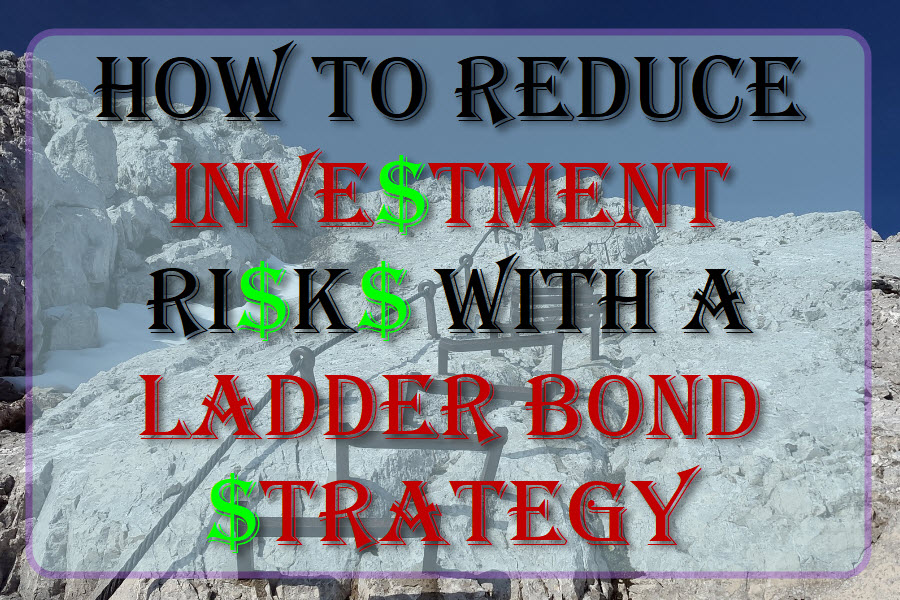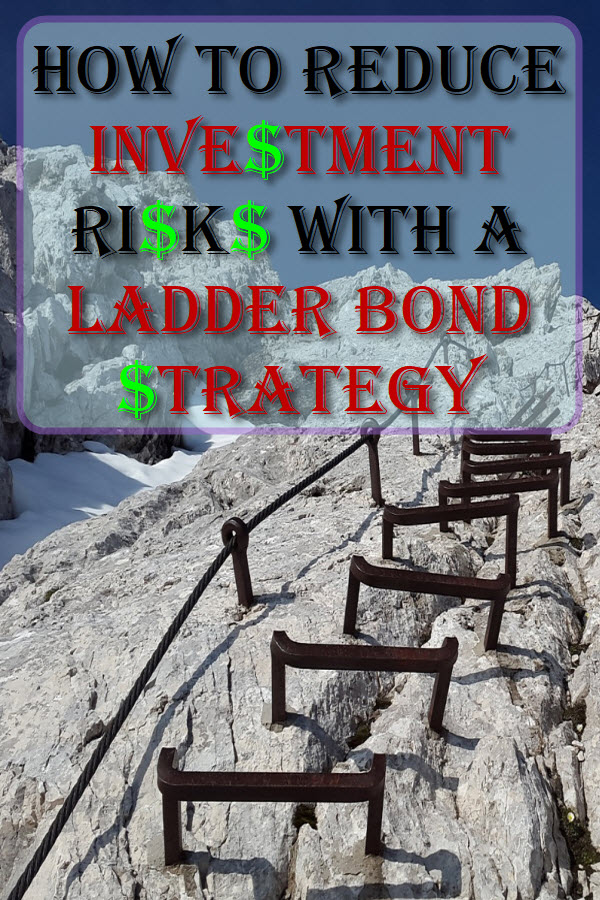
When it comes to my investment portfolio, I have a pretty aggressive approach. Most of my investments are invested in either stocks or ETFs. I haven’t put a lot of consideration into investment risk management and portfolio stabilization at all. I am not sure if it’s my high-risk tolerance or the low-interest rates for the last ten years, fixed-income investments don’t seem to interest me much (pun intended).
Rising Interest Rates
For the past year, the Bank of Canada had raised interest rate three times to 1.25%. The Federal Reserve in the U.S. raised their interest rate six times since the financial crisis in 2008. With interest rates rising, I am starting to be a little bit curious about the fixed-income part of my portfolio since I have next to nothing invested in fixed-income.
Ladder Bond Strategy
I remember a few years ago, I came across a great fixed-income investment strategy that can lower my investment risk and increase my returns. It’s called a ladder bond strategy. Essentially, the ladder bond strategy is to break your investments into a few equal buckets and invest each bucket in fixed-income instruments like GIC or government bonds with different interest rates and maturity dates.
By breaking your fixed-income investments into equal buckets and invest in different maturity dates, you reduce the risk of having all your money locked up at the same time. In addition, you’ll have more flexibility to choose your investment options over time and take advantage of opportunities when they arise.
As each bucket of your fixed-income investment matures, you renew it at the longest maturity date to earn more interest. Keep on repeating this process for a while, you’ll eventually earn the maximum interest and reduce your investment risks significantly. To demonstrate, let’s take a look at a popular example of a 5-year ladder bond strategy by investing $50,000 in one to five years GICs.
Investment Example
To start, we break our investment into five equal buckets of $10,000 each. We’ll invest each of these buckets into GICs with a one to five years maturity dates. I often use RateHub.ca to check out the best GIC rates for my local market, Toronto as of early April 2018. Here is what my initial investment looks like.
| Amount | Investment Term | Years To Maturity | Interest Rate | Interest Earned |
|---|---|---|---|---|
| $10,000 – 1 | 1-Year | 1 | 2.75% | $0.00 |
| $10,000 – 2 | 2-Year | 2 | 3.10% | $0.00 |
| $10,000 – 3 | 3-Year | 3 | 3.15% | $0.00 |
| $10,000 – 4 | 4-Year | 4 | 3.20% | $0.00 |
| $10,000 – 5 | 5-Year | 5 | 3.26% | $0.00 |
Investment After One Year
After one year, the bucket with a maturity date of one year matures. The rest of the four other buckets’ maturity date shortened by one year. I renew the $10,000 – 1 that matured after the first year with a five-year term. Here is what my investment looks like at the beginning of year 2.
| Amount | Investment Term | Years To Maturity | Interest Rate | Interest Earned |
|---|---|---|---|---|
| $10,000 – 2 | 2-Year | 1 | 3.10% | $310.00 |
| $10,000 – 3 | 3-Year | 2 | 3.15% | $315.00 |
| $10,000 – 4 | 4-Year | 3 | 3.20% | $320.00 |
| $10,000 – 5 | 5-Year | 4 | 3.26% | $326.00 |
| $10,000 – 1 | 5-Year | 5 | 3.26% | $275.00 |
Investment After Two Years
After two years, the bucket with a maturity date of two years matures. The rest of the four other buckets’ maturity date shortened by one year. I renew the $10,000 – 2 that matured after two years with a five-year term. Here is what my investment looks like at the beginning of year 3.
| Amount | Investment Term | Years To Maturity | Interest Rate | Interest Earned |
|---|---|---|---|---|
| $10,000 – 3 | 3-Year | 1 | 3.15% | $639.92 |
| $10,000 – 4 | 4-Year | 2 | 3.20% | $650.24 |
| $10,000 – 5 | 5-Year | 3 | 3.26% | $662.63 |
| $10,000 – 1 | 5-Year | 4 | 3.26% | $609.97 |
| $10,000 – 2 | 5-Year | 5 | 3.26% | $629.61 |
Investment After Three Years
After three years, the bucket with a maturity date of three years matures. The rest of the four other buckets’ maturity date shortened by one year. I renew the $10,000 – 3 that matured after three years with a five-year term. Here is what my investment looks like at the beginning of year 4.
| Amount | Investment Term | Years To Maturity | Interest Rate | Interest Earned |
|---|---|---|---|---|
| $10,000 – 4 | 4-Year | 1 | 3.15% | $991.05 |
| $10,000 – 5 | 5-Year | 2 | 3.20% | $1,010.23 |
| $10,000 – 1 | 5-Year | 3 | 3.26% | $955.85 |
| $10,000 – 2 | 5-Year | 4 | 3.26% | $976.14 |
| $10,000 – 3 | 5-Year | 5 | 3.26% | $975.08 |
Investment After Four Years
After four years, the bucket with a maturity date of four years matures. The rest of the four other buckets’ maturity date shortened by one year. I renew the $10,000 – 4 that matured after four years with a five-year term. Here is what my investment looks like at the beginning of year 5.
| Amount | Investment Term | Years To Maturity | Interest Rate | Interest Earned |
|---|---|---|---|---|
| $10,000 – 5 | 5-Year | 1 | 3.26% | $1,369.16 |
| $10,000 – 1 | 5-Year | 2 | 3.26% | $1,131.01 |
| $10,000 – 2 | 5-Year | 3 | 3.26% | $1,333.96 |
| $10,000 – 3 | 5-Year | 4 | 3.26% | $1,332.87 |
| $10,000 – 4 | 5-Year | 5 | 3.26% | $1,342.76 |
Investment After Five Years
After five years, the bucket with a maturity date of five years matures. The rest of the four other buckets’ maturity date shortened by one year. I renew the $10,000 – 5 that matured after five years with a five-year term. Here is what my investment looks like after 5 years.
| Amount | Investment Term | Years To Maturity | Interest Rate | Interest Earned |
|---|---|---|---|---|
| $10,000 – 1 | 5-Year | 1 | 3.26% | $1,681.81 |
| $10,000 – 2 | 5-Year | 2 | 3.26% | $1,703.44 |
| $10,000 – 3 | 5-Year | 3 | 3.26% | $1,702.32 |
| $10,000 – 4 | 5-Year | 4 | 3.26% | $1,712.54 |
| $10,000 – 5 | 5-Year | 5 | 3.26% | $1,739.80 |
From the table above, after four years, all the different investment buckets are earning the five-year interest rate, but all of them have different maturity dates. The total interest income earned for each bucket is pretty similar. If there is a wider spread in interest rates between the different terms, there will be a meaningful difference in the interest income earned for each bucket.
My Two Cents
Depending on your age, risk tolerance, and investment horizon, it’s always prudence to have a portion of your portfolio allocated in fixed-income. As you age, your investment portfolio should tilt towards the fixed-income side as cash flow and capital preservation become a priority. Using a ladder bond strategy will be able to help you achieve both of those priorities.
So readers, how aggressively are you investing your money? Would you consider using a ladder bond strategy to help you lower your investment risk and increase your income? What is your portfolio mix in terms of fixed-income and stocks?


 About Leo
About Leo
nicely written post Leo
Like you, maybe I’m high risk but I don’t do the gic’s yet. At 35 I feel I have alot of time to let my money grow. As I approach retirement this may be a great strategy to put in the toolbox.
Cheers
My mom used to do laddered GIC’s for our savings growing up. I don’t have any GIC’s now and would rather have my money in high interest savings accounts for fixed income.